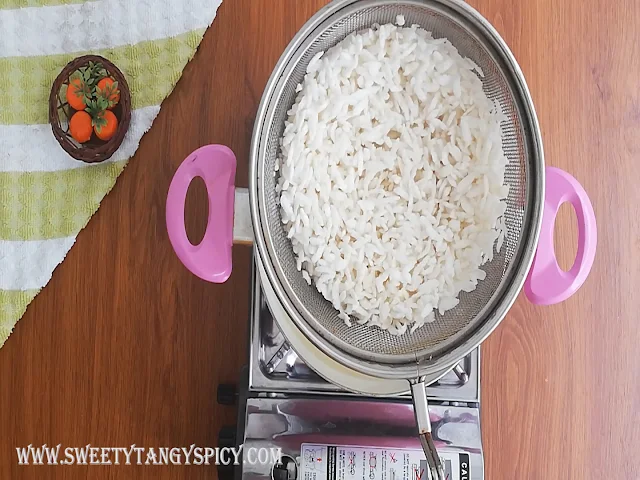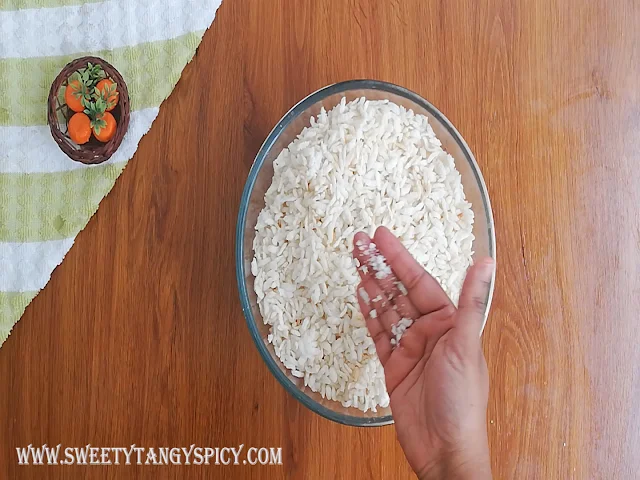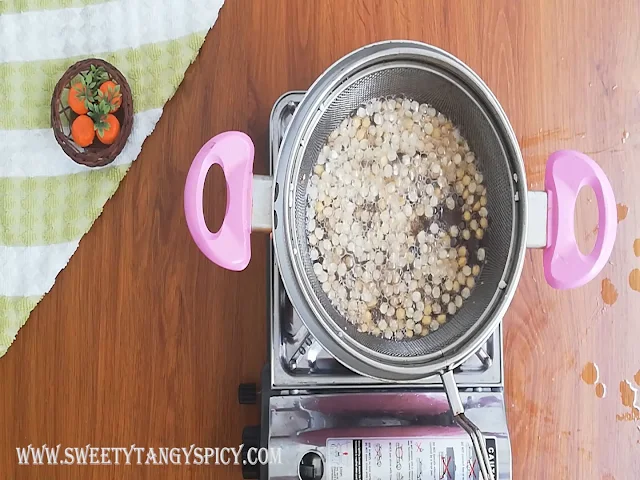Poha Chivda recipe with step by step photos and video.
Chivda is a spicy and savory Indian snack made with rice flakes, nuts, and spices. In South India, it is a well-liked bakery snack, and some people prepare chiwda at home on special occasions like Ganesh Chathurthi, Deevali, Holi, etc. It is a quick vegan evening snack that I can prepare for my children.
What is poha chivda?
When prepared using flattened rice flakes or poha, this popular Indian snack is known as a poha chivda. Poha is the Hindi word for flattened rice flakes. In Kerala, chivda is referred to as aval mixture. The word for flattened rice flakes in Malayalam is aval.
Poha namkeen or poha ke chivda are another name for poha chivda. The Hindi word "namkeen" is used in North India to refer to a variety of salty or savoury snacks.
When making poha chiwda traditionally, the ingredients are first deep-fried until crisp, and then mixed with fried nuts and spices. This is the original and best poha chivda or aval mixture.
When selecting the flattened rice flakes for the deep-frying method, you must be more careful. In the shops, rice flakes come in three different thickness: thin, medium, and thick. Thick poha is the greatest option for deep frying. While you fry, the other two will get soggy.
The second approach, which is a healthy alternative, involves dry roasting the rice flakes until they are crisp then mixing them with fried coconut, almonds, and other seasonings. If you are a newbie, this method is the best and most error-free for you. For this method, use medium or thin rice flakes.
The microwave or OTG oven method is the third technique. The flattened rice flakes, called poha, are first crisped up in the OTG or microwave. Use thin rice flakes and microwave for one minute to implement this technique. The time will vary slightly depending on how thick the flattened rice flakes are. In a similar manner, nuts are microwaved as well. Finally, a tempering is made by combining asafoetida, dried red chili, curry leaves, and cumin seeds in a very small amount of oil.
Sundried method is the fourth technique. This technique is very effective when using extremely thin rice flakes. Flattened rice flakes, also known as poha, are sun-dried till crisp. After that, it is combined with other fried components like nuts and seasonings. Comparatively speaking, this can be thought of as a healthy choice.
In India, you may easily find flattened rice flakes in two shades: red and white. White rice flakes are used to make the dish chivda.
What are the ingredients of a poha chivda?
- Poha or Falattened Rice Flakes :- Flattened rice flakes, often known as poha, are the major component in a poha chivda. Choose the rice flakes according to the type you want. We have already discussed this in the section above, although only briefly. Use thick poha, aval, or flattened rice flakes for traditional deep-fried poha cheevdas, while use medium or thin poha, aval, or flattened rice flakes for dry roasting and microwave/otg oven, respectively.
- Peanut :- Poha chivda must include peanuts or ground nuts as a mandatory ingredient. In fact, it is a spicy North Indian poha mixture, and a spicy mixture is incomplete without peanuts.
- Roasted gram:- The second commonly seen ingredient in a spicy mixture is roasted grams, also known as daria dal or pottukadala. The Hindi name for roasted chickpeas is daria, but the Malayalam equivalent is pottukadala. Use of daria or pottukadala produces a lovely crunchy effect.
- Dry fruits:-Anything you can fit in a chivda, including cashews, raisins, almonds, and walnuts. Anything you can fit in a chivda, including cashews, raisins, almonds, and walnuts. However, cashews are used more often, perhaps because they are so widely accessible.
- Coconut -In traditional chivda, large bits of desiccated coconut, called kopra, are also added. However, I haven't noticed this component in chivda that is sold by south Indian bakeries. If you'd like, add; otherwise, ignore.
- Flavoring ingredients - The seasonings used are cumin seeds, asafoetida, curry leaves, dried red chilies, and turmeric powder.
- Salt - to season
- Sugar - to get a slight sweetness
Poha Chivda - Expert's tips
- Choose the cooking technique based on the kind of flattened rice flakes or poha you're using to make chivda. Use thick rice flakes for authentic fried chivda. The ideal poha to use when preparing the pan-roasted poha chivda is medium or thin poha.
- Each ingredient has a different cooking point, so they must all be roasted separately. To avoid burning, try to keep the flame on low or medium at all times.
- Chivda is made spicy by adding red chilies and chilli powder. Sometimes people use green chilies in place of red chillies. Adjust the spiciness to your taste in both cases.
- Sometimes, instead of using all three of the aforementioned methods, handmade poha chivda is prepared with sun-dried flattened rice flakes. In this circumstance, paper-thin poha or flattened rice flakes are used.
- You can keep the poha in airtight containers once it has reached room temperature. Poha will collect moisture and get soggy if the container is closed while the chivda is still hot.
How to make poha chiva at home
Poha chivda recipe | Spicy poha chivda | Poha Namkeen Recipe
Savory Indian Snack with flattened rice flakes
Preparation time: 5 minutes | Cooking time: 15 minutes | Total time: 20 minutes
Ingredients
- 2 cups flattened rice flakes / poha / aval
- 1/3 cup peanuts
- 1/4 cup roasted gram
- 1/4 cup cashew nuts
- 1/4 cup almonds, slit
- 2 dried red chilies
- 2 small spring curry leaves
- One generous pinch of asafoetida
- 1/4 teaspoon turmeric powder
- 1/2 teaspoon red chili powder (adjust to your taste)
- 1/2 teaspoon cumin seeds (optional)
- 1 teaspoon powdered sugar or powdered jaggery
- Salt to taste
- 3 tablespoon oil
Preparation of poha chivda with step by step pictures
- Poha/aval will be deep-fried first. Heat the sunflower oil in a wok for deep frying. I didn't use coconut oil today because I wanted the chivda to keep fresh for a few days. Namkeens fried in coconut oil have an extremely short shelf life and develop a foul odour over time. So any flavorless oil, such as sunflower oil or corn oil, is preferable.
- We will fry the poha chivda ingredients once the oil reaches the ideal temperature for frying. To test the oil, drop one flattened rice flake/poha/aval into it; if it quickly lifts and puffs, our oil is ready.
- I used one flat metal sieve to fry the ingredients. Rice flakes should be fried in batches. Transfer the first batch of rice flakes into the sieve. Immerse the sieve slowly in the hot oil.
- The rice flakes will immediately puff up and get a light brown color. Never overcook the rice flakes; once fried, they should be a lovely off white tint.
- Fry the remaining flattened rice flakes / poha / aval batches. Put in a clean, dry mixing bowl and set aside. Don't worry if the oil turns a darker color after frying the flattened rice flakes; this is perfectly natural. This is due to the presence of residues of rice flour stick on the flattened rice flakes, which become separated in oil frying and charred.
- Simply press some fried, flattened rice flakes between your fingertips to determine their doneness. With just a tiny press, rice flakes can be readily crushed.
- Next, we'll fry the spices and nuts. Since each of these ingredients has a different cooking temperature, it is best to fry them separately. The peanuts will be fried first. To prevent discoloration, keep the flame at a constant medium. For the right crispiness, shake the sieve or mix it regularly with a spatula. As soon as the peanuts get crisp and start to turn a light brown color, transfer to a dry bowl.
- Put pottukadalai or roasted chickpeas. The roasted chickpeas cook really quickly. Remove from oil as soon as they turn a light brown color.
- Cashews are then fried till crisp and light brown.
- Walnuts, almonds, raisins, and other nuts are among the options for extra nuts. Almonds were used today. I simply split it in half and fried it until light golden and crisp.
- Poha chivda is sometimes served with kopra, which are fried chunks of coconut. Then, fry the kopra until it turns golden brown and stops bubbling. Avoid it if you have no interest in adding kopra. One day prior to preparation, I chopped small pieces of coconut and sun-dried them to make kopra.
- Curry leaves and dried red chilies should be fried at this point. Red chilies should be broken before cooking. Transfer from oil as soon as the spices become crisp and stop cracking.
- Now add all of the fried spices and nuts to the bowl of fried rice flakes. Add salt, turmeric powder, asafoetida, and red chilly powder. Perform this step while the fried ingredients are still warm.
- Simply combine thoroughly with a dry spoon, and the poha chivda is ready. As soon as the chivda reaches room temperature, store in a dry, airtight container. The chivda can be kept for up to a month in airtight containers. It won't taste bad or lose its crispness for a month.
- Enjoy.























0 Comments